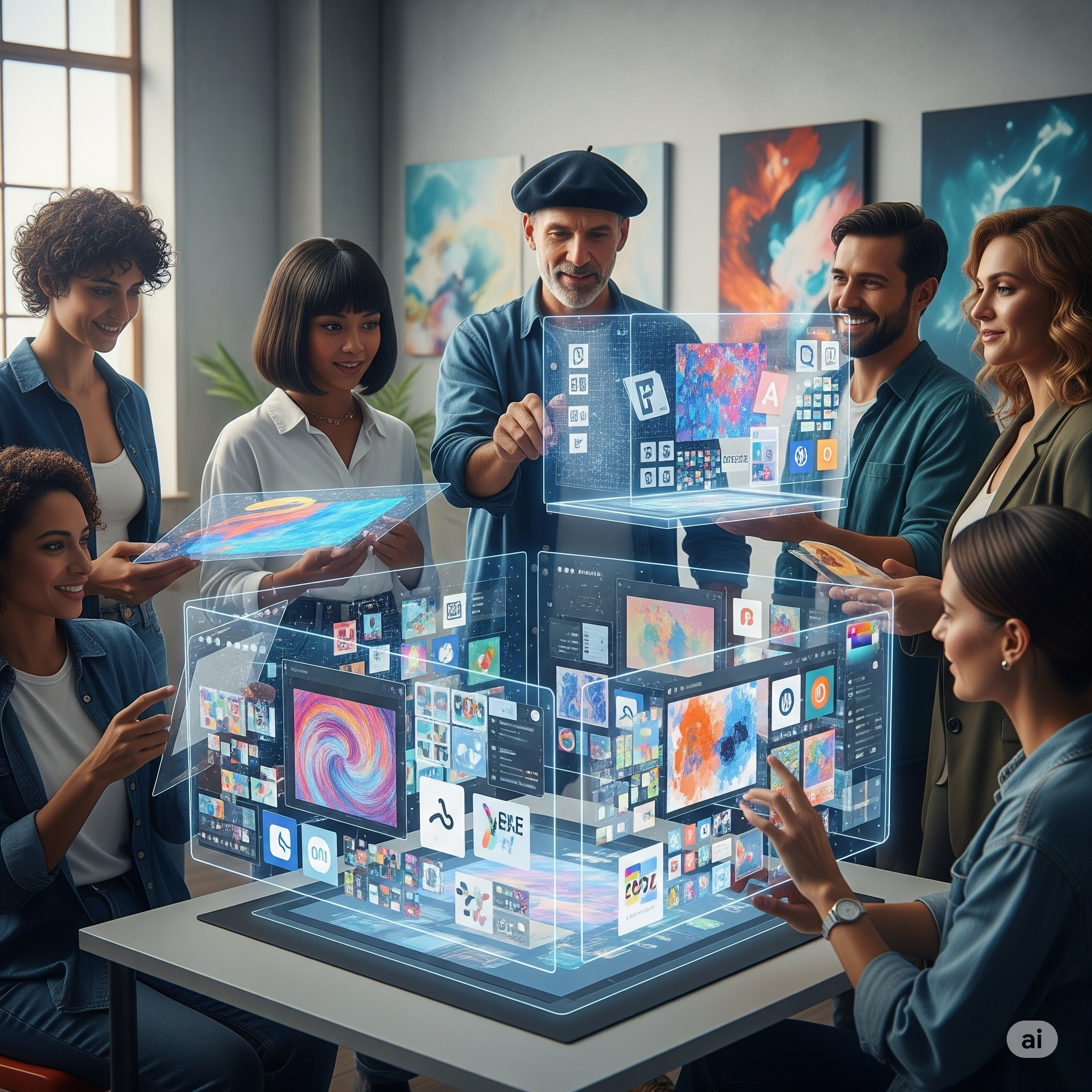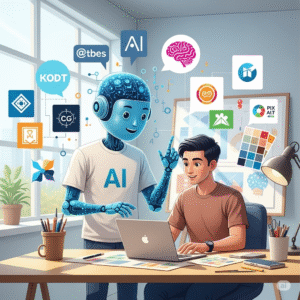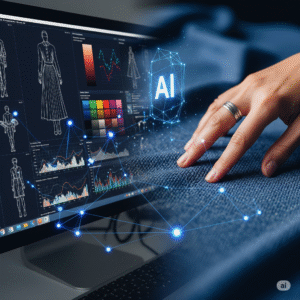The canvas is changing. The brushstrokes are evolving. What was once solely the domain of human creativity and meticulous manual effort is now being profoundly influenced by the algorithms and insights of artificial intelligence. We’re not just talking about automating simple tasks anymore; we’re witnessing a complete paradigm shift in how design is conceived, created, and consumed. The future of AI graphic design isn’t about machines replacing human artists, but about empowering them with unprecedented tools and capabilities, ushering in an era of intelligent design.
From generating unique visual concepts to refining complex layouts in seconds, AI graphic design is rapidly becoming an indispensable partner for creatives. This transformation extends beyond graphic design into the broader realm of art, where AI art generation is pushing the boundaries of what’s visually possible. This blog post will explore how AI is reshaping the creative landscape, providing real-world examples, actionable insights, and a glimpse into the exciting possibilities that lie ahead for designers and artists.
The AI-Powered Creative Assistant: Beyond Basic Automation
For years, designers have embraced software that streamlines their workflow. But AI takes this to an entirely new level. Imagine having a tireless creative assistant that can analyze vast amounts of visual data, understand design principles, and even anticipate trends. That’s the power of AI graphic design today. It’s moving far beyond simple automation, evolving into a sophisticated partner that assists in conceptualization, iteration, and optimization.
AI can quickly generate multiple variations of a logo, suggest optimal color palettes based on brand guidelines and emotional impact, or even design entire website layouts from a simple text prompt. This doesn’t diminish the designer’s role; instead, it frees them from repetitive tasks, allowing them to focus on high-level strategy, client communication, and the truly unique creative leaps that only human intuition can provide. The symbiotic relationship between human creativity and AI efficiency is defining the new frontier of design.
From Concept to Canvas: Revolutionizing Visual Ideation with AI
One of the most exciting advancements in the future of AI graphic design is its ability to accelerate the ideation phase. Historically, brainstorming visual concepts could be a time-consuming process involving extensive mood boarding, sketching, and manual experimentation. Now, AI can kickstart this process, offering a wealth of initial ideas that can then be refined by a human designer.
Tools capable of AI art generation are at the forefront of this revolution. Give them a few keywords, and they can produce a diverse array of images, illustrations, or abstract art that might spark entirely new directions for a project. This capability is invaluable for designers facing tight deadlines or creative blocks. It’s like having an infinite visual library that can be instantly customized to your needs. This rapid prototyping allows designers to explore more avenues, present more options to clients, and ultimately arrive at a stronger, more impactful final product.
Case Study 1: Streamlining Brand Identity with AI
Consider “Phoenix Innovations,” a burgeoning tech startup that needed a distinctive brand identity. Their small design team was overwhelmed with the task of creating multiple logo concepts, color schemes, and marketing collateral under a tight deadline. They decided to leverage AI for their initial ideation.
Using an AI graphic design platform, they input keywords describing their brand values (e.g., “innovation,” “growth,” “connection,” “futuristic”). The AI instantly generated hundreds of logo variations, each with unique typography, iconography, and color palettes. “It was like having a brainstorming session with a thousand creative minds simultaneously,” says Sarah Jenkins, Phoenix Innovations’ Lead Designer. “While not all outputs were perfect, the sheer volume and diversity of ideas allowed us to quickly narrow down our aesthetic direction. We identified core elements we liked, then refined them manually in traditional design software. This process cut our initial concept development time by over 60%, allowing us to focus on intricate details and consistent application across all brand touchpoints.” This demonstrates how AI amplifies, rather than replaces, the human designer’s role.
AI Tools Powering the Design Revolution
The market is currently flooded with innovative AI tools designed to assist graphic designers and artists. These tools vary widely in their capabilities, from simple image enhancements to complex generative art. Here are a few prominent examples:
- Adobe Sensei (Integrated into Adobe Creative Cloud): While not a standalone tool, Adobe Sensei powers many AI features within popular Adobe products like Photoshop, Illustrator, and InDesign. It assists with tasks such as content-aware fill, automatic photo tagging, font matching, and intelligent layout adjustments. It’s truly at the forefront of AI graphic design integration. Explore more about Adobe’s AI capabilities at https://www.adobe.com/sensei.html.
- Midjourney and DALL-E 3 (via OpenAI): These are leading AI art generation tools that create stunning images from text prompts. They are invaluable for generating concepts, textures, illustrations, and even photorealistic images, pushing the boundaries of what’s possible in visual ideation. DALL-E 3 is accessible through ChatGPT Plus and other integrations at https://openai.com/dall-e-3.
- Canva’s Magic Design/Magic Edit: For designers and non-designers alike, Canva has integrated AI to help create designs quickly. Its “Magic Design” feature generates templates from text or media, while “Magic Edit” allows for AI-powered image manipulation. This democratizes AI graphic design, making powerful tools accessible to a broader audience. Visit Canva at https://www.canva.com/.
AI graphic design
- Figma with AI Plugins: Figma, a popular collaborative design platform, now boasts a growing ecosystem of AI plugins. These plugins can assist with everything from organizing layers and components to generating placeholder content or even suggesting design improvements based on user patterns. This enhances the workflow for UI/UX designers, among others.
- RunwayML: This platform offers a suite of AI-powered creative tools, including text-to-image generation, video editing features, and tools for manipulating existing media. It’s a versatile option for designers and artists looking to experiment with cutting-edge AI capabilities. Check out RunwayML at https://runwayml.com/.
These tools exemplify how AI graphic design is not about replacing human talent, but augmenting it. They handle the computationally intensive or repetitive tasks, allowing designers to focus on the nuanced, strategic, and emotionally resonant aspects of their work.
Case Study 2: Personalizing Advertising Creatives with AI
A major e-commerce retailer, “StyleSync,” faced the challenge of creating highly personalized advertising creatives for millions of customers across diverse product categories. Manually designing thousands of unique ad variations was impossible. They turned to AI graphic design to solve this scalability issue.
StyleSync implemented an AI system that analyzed customer purchase history, Browse behavior, and demographic data. This AI then dynamically generated ad creatives (images, headlines, calls-to-action) tailored to individual preferences. For instance, a customer who frequently bought sustainable fashion might see an ad with an eco-friendly aesthetic and messaging, while another interested in luxury items would see a more opulent design.
“The impact on our conversion rates has been phenomenal,” says Lisa Tran, Head of Marketing at StyleSync. “Our AI system, leveraging capabilities similar to those found in platforms like DALL-E 3 for image generation and fine-tuned large language models (akin to specialized versions of ChatGPT) for compelling ad copy, personalizes visual content at a scale we could never achieve manually. Our designers now act as curators and supervisors of the AI-generated content, ensuring brand consistency and creative quality. This strategic use of AI graphic design allows us to engage customers on a much deeper, more relevant level, driving significant increases in sales and customer loyalty.”
The Designer’s Evolving Role: From Creator to Curator and Prompt Engineer
As AI graphic design tools become more sophisticated, the role of the human designer is evolving. Rather than solely being the creator from scratch, designers are becoming expert curators, editors, and “prompt engineers.” Crafting effective prompts for AI tools, understanding how to guide the AI to produce desired results, and then skillfully refining those outputs requires a new set of skills.
This shift means designers need to develop a keen eye for what makes an AI-generated image “work” – not just aesthetically, but also functionally for a specific project. They’ll need to understand the nuances of AI output, identify biases, and bring their unique human perspective to polish and perfect the AI’s initial creations. Furthermore, ethical considerations regarding AI-generated art, originality, and intellectual property will become increasingly important conversations within the design community.
Getting Started with AI Graphic Design: Tips for Creatives
Feeling a bit overwhelmed or excited by the possibilities? Here are some beginner-friendly tips and workflows for integrating AI graphic design into your creative process:
- Start Small and Experiment: Don’t feel pressured to master every AI tool at once. Begin with one or two free or affordable tools like Canva’s AI features or a trial of Midjourney. Experiment with simple prompts and observe the outputs. Get comfortable with the interface and the AI’s capabilities.
- Learn Prompt Engineering Basics: The key to effective AI art generation often lies in your prompts. Learn how to be specific, descriptive, and iterative. Start with broad ideas and then refine your prompts based on the AI’s initial responses. Resources from OpenAI and other AI art platforms often offer excellent prompt engineering guides.
- Use AI for Ideation, Not Just Final Output: Think of AI as your brainstorming partner. Use it to generate initial concepts, mood boards, or variations. You can then take these AI-generated foundations into your traditional design software (e.g., Adobe Photoshop, Illustrator) for refinement, branding, and human touches.
AI graphic design
- Focus on Your Unique Human Skills: AI can generate visuals, but it can’t (yet) fully understand complex client needs, cultural nuances, emotional impact, or ethical implications in the same way a human can. Double down on your strategic thinking, empathy, storytelling, and client communication skills. These are your true differentiators in the age of AI graphic design.
- Stay Informed and Adaptable: The AI landscape is evolving at a breakneck pace. Follow industry news, subscribe to design and AI newsletters, and participate in online communities. Continuous learning and adaptability will be crucial for staying ahead in this rapidly changing field. McKinsey has also highlighted the importance of continuous learning and reskilling for professionals to adapt to AI-driven changes across various industries, including creative fields (Source: https://www.mckinsey.com/capabilities/quantumblack/our-insights/the-state-of-ai).
The future of AI graphic design is collaborative. It’s about combining the efficiency and generative power of AI with the irreplaceable intuition, creativity, and strategic thinking of human designers.
Beyond the Canvas: AI’s Impact on the Design Industry and Education
The ripple effects of AI graphic design extend beyond individual workflows to the entire design industry and how future designers are educated. Design agencies might restructure their teams, incorporating AI specialists or prompt engineers. New job roles specifically focused on AI-driven creative workflows could emerge.
Educational institutions are already beginning to integrate AI tools and prompt engineering into their design curricula, preparing the next generation of creatives for this new reality. The emphasis will shift from purely technical software proficiency to critical thinking, problem-solving with AI, and understanding the ethical implications of AI-generated content. This forward-looking approach ensures that the creative industry remains vibrant and innovative.
The journey into the future of AI graphic design is just beginning. It promises a world where creativity is augmented, efficiency is maximized, and the boundaries of visual expression are continually pushed. Embracing this intelligent evolution isn’t just an option; it’s a necessity for any designer or artist looking to thrive in the decades to come.
AI Job Evolution: Automation vs. Augmentation in the Modern Workforce



